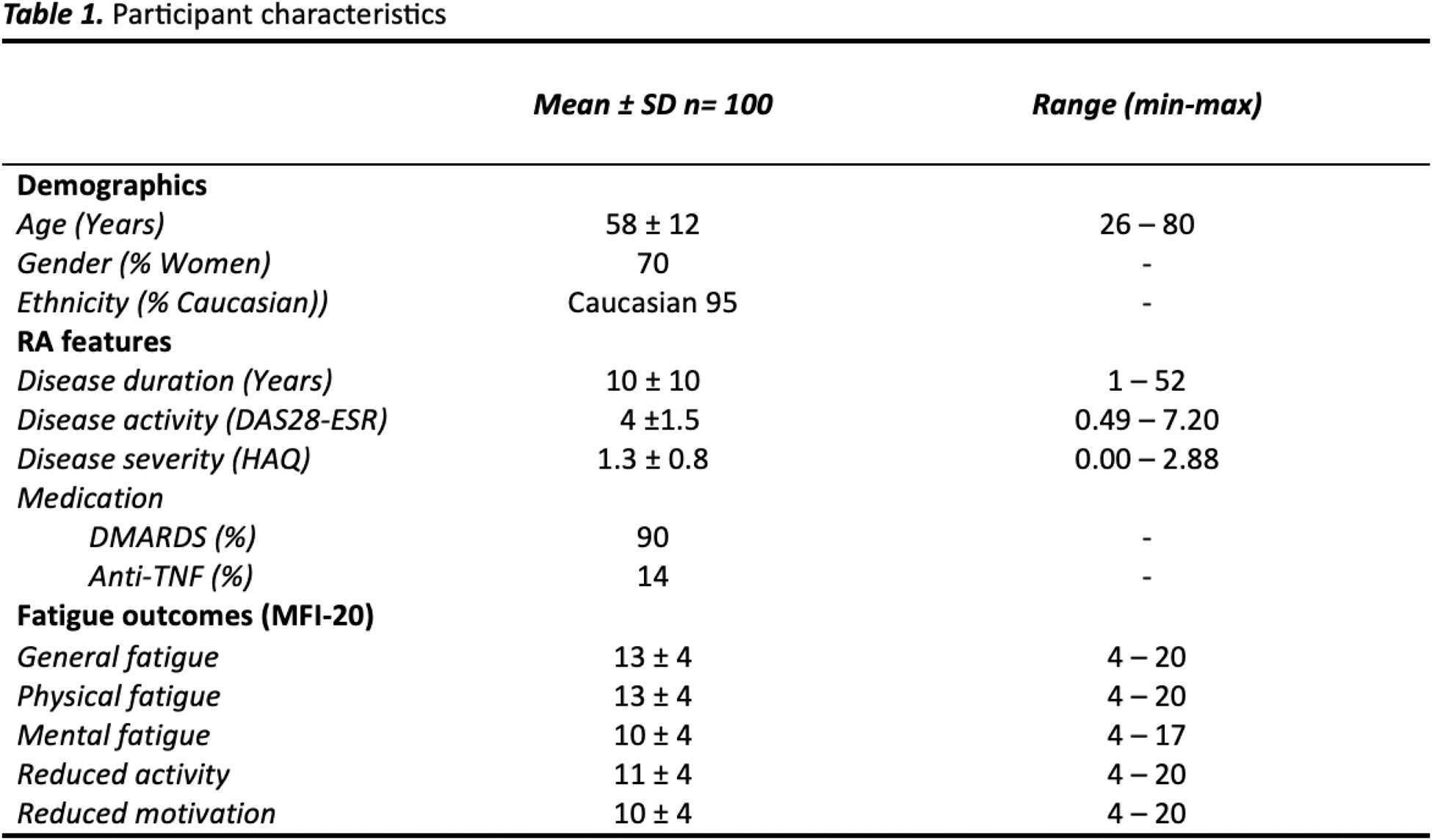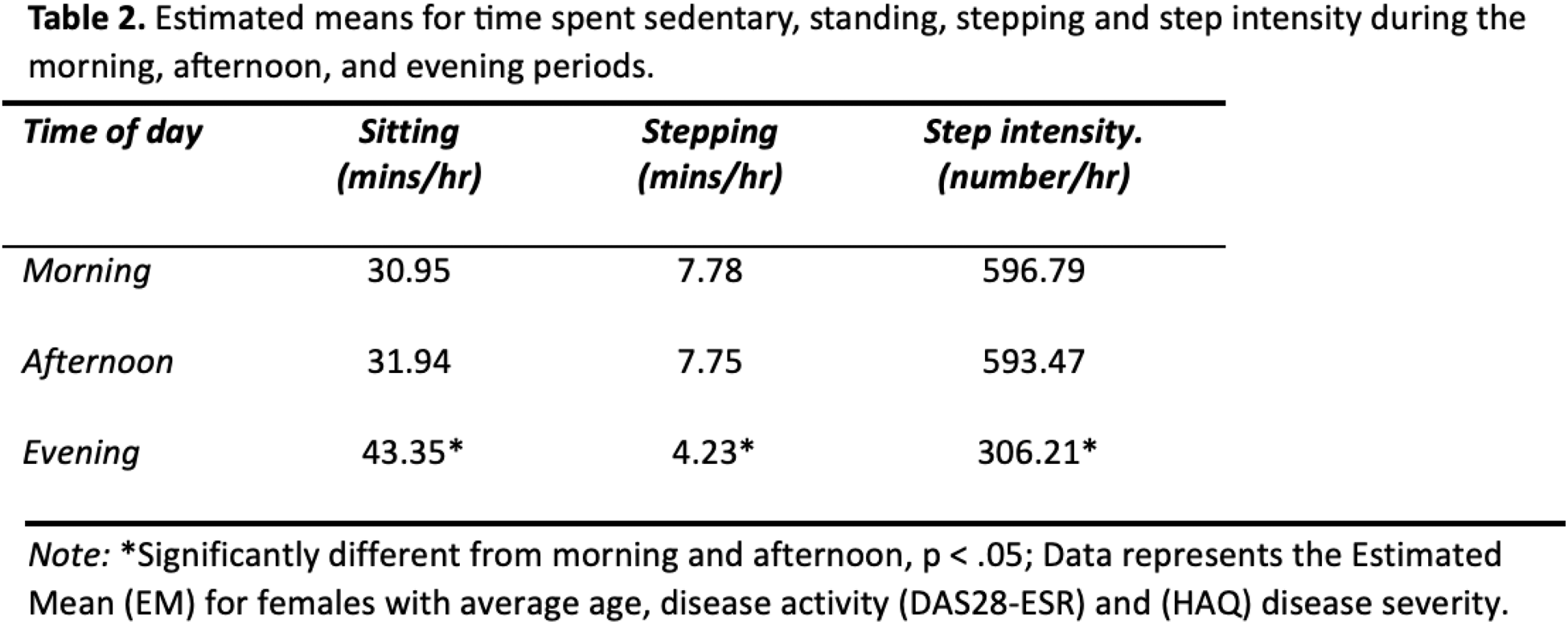

Background: Fatigue is experienced by up to 70% of people living with Rheumatoid Arthritis (RA)[1, 2]. As such, fatigue management is considered a global research priority by both patients and healthcare professionals. Higher levels of physical activity (PA) are reported to be associated with lower levels of fatigue, but the role of sedentary behaviour (SB) is less well understood. In addition, levels of PA and SB vary throughout the day, which may hold implications for variability in the experience of fatigue.
Objectives: To examine 1) diurnal patterns of both PA and SB among people living with RA, and 2) whether these diurnal patterns are associated with multi-dimensional aspects of fatigue in RA.
Methods: Participants with a clinical diagnosis of RA (n = 104) were recruited from Rheumatology outpatient clinics. Participants medical history and demographic information was recorded, and they underwent assessments of RA disease activity (Disease Activity Score-28 Erythrocyte Sedimentation Rate, DAS28-ESR), and severity (Health Assessment Questionnaire, HAQ). Participants also wore an activPAL 3TM for 7 days to measure their habitual SB (sitting time) and PA (stepping time and step intensity). After 7 days, they completed the Multidimensional Fatigue Inventory-20 (MFI-20) to assess their experience of fatigue over the preceding 7 days. Dimensions of fatigue assessed by the MFI-20 are general fatigue, mental fatigue, physical fatigue, reduced activity, and reduced motivation. Data reduction: Participants were excluded from analyses where the activPAL 3TM was worn for <10 hours/day, on <5 days. Days were split into time segments: morning (7:00 to 11.59), afternoon (12:00 to 17.59), and evening (18:00 to 22.59), and sitting time, stepping time, and step intensity were averaged across these periods. Where participants provided only 1 hour of valid data for a particular time period, this was excluded from analysis. PA and SB variables were expressed as minutes/hour (sitting and stepping time) and steps/hour (step intensity). Statistical Analysis: Mixed Linear Modelling (MLM) explored changes during the day in PA and SB variables, adjusted for RA disease activity, severity, sex, and age. The within-subject level predictor was time (centred by assigning 0 to morning), with sex (female = 0), mean centred age, disease activity and severity entered as level 2 (between-person) covariates. Subsequently, mean centred fatigue was added to this model as a between-person predictor, with each fatigue dimension analysed separately. Potential differences in diurnal patterns of PA and SB with varying levels of fatigue were explored using mean-centred fatigue by time interactions ( Note : interactions indicate whether the rate of change from morning PA/SB to afternoon or evening, is similar for varying levels of fatigue for a female of average age, disease activity and severity).
Results: Results indicated similar stepping time and intensity in the morning and the afternoon, but significantly lower levels in the evening (compared to morning and afternoon periods). Sitting time was significantly higher in the evening compared to the morning and afternoon. Stepping time and step intensity were both significantly negatively related to general fatigue [values are Estimated Mean [EM], time = -0.15, p = .04, intensity = -17.5, p = .008), physical fatigue [time = -0.25, p = .00, intensity = -26.5, p = .00], reduced activity [time = -0.16, p = .04, intensity = -14.7, p = .04], and reduced motivation [time = -0.16, p =.04, intensity = -13.9, p = .04] outcomes. No associations were found for mental fatigue [time = -0.06, p = .47, intensity = -6.5, p = .35]. Significant interaction effects indicated stepping time and intensity in the evening were both positively associated with general fatigue [time = 0.18, p = .02, intensity = 19.3, p = .00] and physical fatigue [time = 0.15, p = .04, intensity = 17.1, p = .01].
Conclusion: Results suggest the evening represents the most sedentary (highest sitting time), and least active (lowest stepping time and intensity) period of the day for people living with RA. The interaction between general and physical fatigue and stepping time and intensity suggests diurnal patterns of PA are associated with variability in fatigue. Diurnal PA patterns should therefore be considered when designing fatigue management interventions for RA.
REFERENCES: [1] Overman CL, Kool MB, Da Silva JA et al. The prevalence of severe fatigue in rheumatic diseases: an international study. Clinical Rheumatol, 2016, 35:409.
[2] Brady SM, Veldhuijzen van Zanten JJCS, Dinas PC et al. Effects of lifestyle physical activity and sedentary behaviour interventions on disease activity and patient- and clinician- important health outcomes in rheumatoid arthritis: a systematic review with meta-analysis. BMC Rheumatol , 2023, 7(1):27.


Acknowledgements: We would like to acknowledge all of the participants who took part in this research.
Disclosure of Interests: None declared.
© The Authors 2025. This abstract is an open access article published in Annals of Rheumatic Diseases under the CC BY-NC-ND license (